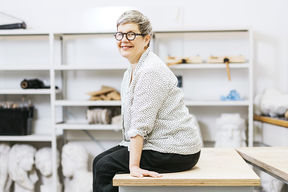Everyday choices: What are arts teachers needed for, Marja Rastas?

Aalto University trains art teachers, who go on to work in comprehensive and secondary schools as well as art schools. Is there enough work for them?
About thirty students are accepted each year, and the aim is for the same amount to graduate annually. Changes in the standing of the visual arts subject in the comprehensive and secondary school curricula directly affect the number of jobs available in the teaching sector.
Our graduates work quite diversely in art education positions or as experts and researchers. Some graduates are self-employed in various art and art education positions. They combine teaching, development, socio-cultural art projects and their own work, which can result in interesting new practices.
It looks like the world has a void that art education can fill: our graduates are in ever increasing demand in various sectors of society. A good example is the arrival of art educators at libraries and early childhood education. In other words, we are training art education professionals with lifelong and all-round learning in mind.
Why should visual arts be taught in schools – aren’t they more of a hobby? And what if you just can’t draw at all?
As a school subject, visual arts is much more than just drawing. It encompasses artistic thinking, exploring and critically examining phenomena in visual culture, challenging your own thoughts with art as well as learning different methods of communication, interaction and influencing. These are things that affect all of us, whoever you may be.
And if you think that you can’t draw at all, it could be you’ve failed to notice how multi-faceted a tool drawing is. A skilled teacher can instruct you in a way that leads you to notice you can do something you thought was beyond you.
In 2017, the Ministry of Education published a report on the role of the creative industries in strengthening the economy and employment in Finland. According to it, cultural sectors generate 3.6% of GDP, i.e. more than, for example, forestry. Still, it feels like they aren’t taken seriously. What can be done about this?
As an educator of teachers, I would say that we need to look after the arts subjects by arguing for them persistently, loudly and with sophistication. Providing a growing person with an in-depth foundation in the arts early fosters a personal relationship with art and, ideally, insight into the broader significance of art and culture.
I agree with philosopher Martha Nussbaum who calls for the teaching of art and the humanities to be made part of the curricula of all universities. She says art develops the ability to put yourself in someone else’s shoes – it is directly linked to the development of ethical thinking and eco-social justice. Here at Aalto, we have a unit that provides art education to all students. University-Wide Art Studies (UWAS) is an excellent example of how this can be carried out in practice.
What got you into the field?
Visuality has been important to me since childhood. My home was encouraging and supportive of my interests. At first, I studied Finnish, literature, theatre studies and art history, but wound up, almost by chance, in the art education department at what was then the University of Art and Design Helsinki.
I haven’t worked as a school teacher, although I have performed other teaching duties related to the visual arts since I was a student in the mid-1980s. I started with children and young people, after which I worked in adult education for a long time. My own doctoral studies led me to become a teacher at my alma mater.
Working on curriculum planning, the development of teaching, is my passion. In my former job, I worked as the head teacher of a visual communications programme for almost 15 years. It was my 'pedagogic laboratory'. During that time, I started studying for a doctorate and adopted the attitude of a researching teacher. This experience made it easy to transfer to Aalto for work.
In my present job, our fantastic students make sure that my thinking doesn’t stagnate.
Who is your favourite artist?
I can’t give you an individual name, but there are artists who have affected my own thinking, even quite radically. One such example is the composer John Cage. His concert, in which he used rocks, conifer cones and other natural objects he had gathered as instruments, obliterated all divisions in how a young me perceived art.
On the other hand, there are contemporary artists and artworks that open fresh perspectives on the world. An example was Outi Pieski’s recent exhibition Čuolmmadit at the Espoo Museum of Modern Art EMMA. The exhibition dealt with the cultural heritagae of the Sámi people and their relationship with nature in a sensually impressive way. At the same time, it made a powerful political declaration about the rights of a minority culture. The artist succeeded in touching me – not through preaching, but by asking questions.
Text: Krista Kinnunen, Paula Haikarainen.
This article was originally published in the Aalto University Magazine issue 24 (issuu.com) April 2019. The Everyday choices column focuses on the personal choices experts make in association with their field of research.
- Published:
- Updated:
Read more news

Aalto ARTS alum Vidha Samya’s artwork featured at the Venice Biennale 2024
The Pavilion of Finland presents ‘The pleasures we choose’ at the 60th International Art Exhibition – La Biennale di Venezia until 24 November 2024.
IoT Forge donates EUR 1 million to the School of Engineering
The donation will be used for research and education on the Industrial Internet and digital twins.
Join us for the first Aalto Open Science Award Ceremony
All Aaltonians are welcome – no registration required!